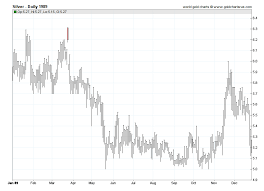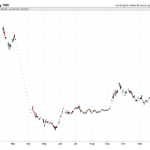This article aims to explore the fluctuations and trends of silver prices in 1989. Using historical data provided by SD Bullion, we will examine the price range throughout the year and identify any monthly trends. The fluctuation of silver prices can have significant implications for industries that rely on the precious metal, as well as for investors who seek to profit from its value. By analyzing the trends and patterns of silver prices in 1989, we can gain insights into the factors that drove these fluctuations and how they may have impacted the market.
Throughout 1989, silver prices saw significant fluctuations, with a high point in January and a low point in May. From July to December, prices ranged from $5.05 to $5.89 per ounce, with a steady increase towards the end of November. However, prices then decreased towards the end of December, reaching a low of $5.22 on December 29th.
Understanding the reasons behind these fluctuations in price can provide valuable insights into the factors that influence the silver market. This article will examine the historical data on silver prices in 1989 to identify any trends or patterns that can shed light on the drivers of these fluctuations.
Historical Silver Data
The historical silver data provided by SD Bullion reveals the daily prices of silver from January to December 1989, ranging from $5.05 oz to $6.21 oz and displaying fluctuations and trends throughout the year. The silver market during 1989 was influenced by various global economic factors such as changes in interest rates, inflation, and political instability. As a result, the global economy experienced significant fluctuations and uncertainty, which had an impact on the silver market.
During the early months of the year, the silver price reached its highest point in January at $6.21 oz and saw a brief spike in March, reaching $6.15 oz. However, the silver price reached its lowest point in May at $5.09 oz and saw a brief dip. Prices fluctuated throughout the months, but they steadily increased from September to November. Prices continued to increase into December, reaching a high of $5.89 oz on November 24, 1989.
The fluctuations in silver prices during 1989 reflect the impact of global economic factors on the precious metal market.
Price Range in 1989
Spanning from January to December of 1989, the range of values for this precious metal fluctuated like a rollercoaster, with highs and lows that were spread apart by several cents on certain days. The price of silver ranged from $5.05 oz to $6.21 oz, with the highest point being in January at $6.21 oz and the lowest point in May at $5.09 oz.
However, the silver market analysis reveals that the price range was not only affected by these two months but was influenced by various factors throughout the year. Factors affecting the price range of silver in 1989 include the supply and demand for silver, the political and economic situation in the United States and other major silver-producing countries, and the performance of the US dollar in the foreign exchange market.
For instance, the brief spike in silver prices in March 1989 could be attributed to strong demand from industrial users, while the steady increase from September to November was partly due to the weakening of the US dollar against major currencies. Overall, the price range in 1989 reflects the dynamic nature of the silver market and the complex interplay of various economic and political factors.
Monthly Trends
Throughout 1989, the value of silver experienced fluctuations that were impacted by various factors such as global economic and political events.
The analysis of monthly trends shows that the price of silver was influenced by both short and long-term drivers.
For instance, the price of silver reached its peak in January 1989, mainly due to the anticipation of increased demand from the electronics industry, which was a significant consumer of the metal.
In March, the price of silver saw a brief spike, driven by the weakening of the US dollar against other major currencies.
Global events such as the Gulf War and the collapse of the Soviet Union in 1989 also had a significant impact on the price of silver.
The uncertainty and instability caused by these events led investors to seek safe havens for their money, resulting in increased demand for precious metals such as silver.
The price of silver continued to increase towards the end of the year, reaching a high of $5.89 oz on November 24, 1989, before decreasing towards the end of December.
Overall, the analysis of monthly trends in 1989 highlights the complex interplay between various drivers of the silver market, emphasizing the importance of considering both short and long-term factors when analyzing precious metal prices.
Frequently Asked Questions
What were the main factors influencing silver prices in 1989?
The main factors influencing silver prices in 1989 were inflation rates and mining production. As inflation rates rose, demand for silver as a hedge against inflation increased. Meanwhile, mining production levels affected the supply side of the market, influencing price fluctuations.
How do the silver prices in 1989 compare to prices in other years?
Comparisons and analysis of silver price trends in 1989 reveal that the metal fluctuated between $5.07 oz and $6.21 oz, with prices reaching a high in January and a low in May. In comparison to today’s prices, silver was relatively cheap in 1989.
What was the impact of major global events on silver prices in 1989?
The impact of political turmoil on silver prices in 1989 was evident, as the metal experienced significant fluctuations throughout the year. Additionally, there was a negative correlation between silver prices and stock market performance, with silver prices often rising during times of economic uncertainty.
How did the demand for silver change during 1989?
Silver demand analysis in 1989 suggests that consumer behavior towards silver was relatively stable. Despite fluctuations in silver prices, demand remained consistent throughout the year, indicating a steady interest in the metal for both investment and industrial purposes.
What were the most common uses of silver during 1989?
Silver in 1989 was primarily used for industrial applications and jewelry manufacturing. Its unique properties, such as high thermal and electrical conductivity, made it useful in electronics, while its aesthetic appeal made it popular in the jewelry industry.





